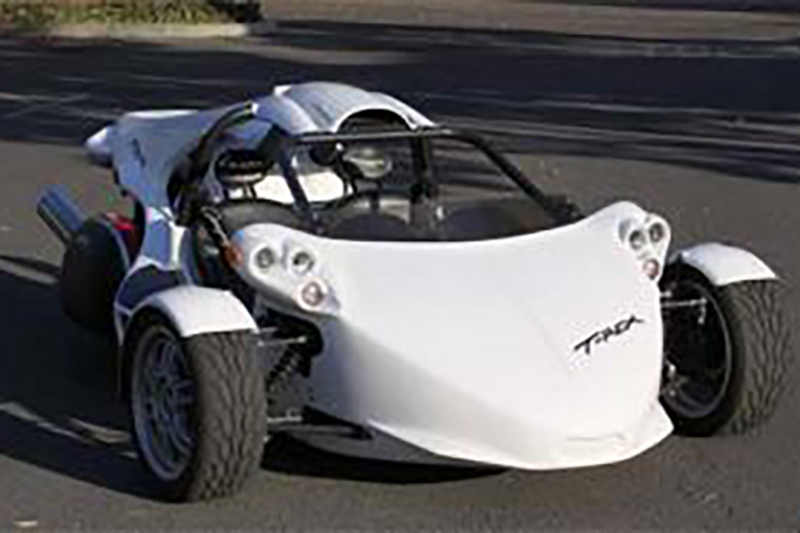2009 Campagna T-Rex 14R

Road Test Review
The first time I saw a T-Rex was on the MTV show Ryan Dyrdek’s Fantasy Factory. Dyrdek, a pro skateboarder with too much money and his own do-whatever-I-want TV show, roared into his dream warehouse—futuristic office, skate park and basketball court all under one roof—and did doughnuts on the slick concrete floor. In a particularly clown car-like moment, L.A. Lakers’ Lamar Odom shoehorned part of his body into the passenger seat while the rest of him hung out like a giraffe riding shotgun in a Kharman Ghia. After they shared a few laughs and Odom contemplated possible violations of his NBA contract, they sensibly hopped into Dyrdek’s blinged-out SUV and drove to the soon-to-be-opened downtown Asian fusion restaurant where both are investors, leaving the T-Rex behind to sulk.
A rich kid celebrity like Dyrdek is the ideal customer for Campagna’s T-Rex 14R, which is a high-powered, three-wheeled go-kart with a starting price of $49,995 (plus $1,250 for “transport”). There isn’t a single microscopic iota of practicality in the T-Rex, which lacks doors, windows and a windshield, requires the driver and passenger to wear helmets and has about as much interior space as a Matchbox car. Don’t get me wrong, the T-Rex is an absolute scream to drive. It’s just that the T in T-Rex must stand for Toy (or Trouble) because this ain’t no grocery getter.
The T-Rex is built by Campagna, which is based in Montréal, Canada. (Having just tested the Can-Am Spyder RT-S, I can’t help but wonder: What it is about the Québécois and two-in-the-front three-wheelers?) This sharp-toothed dino-car, which would be more appropriately named the Triceratops, has been in production since 1996. It was powered by a Suzuki GSX-R1100 engine until 2000, when Campagna bolted in a Kawasaki ZX-12 engine, followed by Kawi’s ZZR1200 engine and finally the ZX-14 powerplant in our test machine. Citing Kawasaki figures, Campagna claims 200 horsepower, measured at the crank of course. Rather than between your legs, the engine sits behind the driver/passenger, with two large ram-air hoses extending from the intake on top of the roll cage to the engine compartment. The open cockpit makes for a noisy experience; wear ear plugs.
A large chain transmits power to the 10-inch-wide, 17-inch-diameter rear wheel, which is fitted with a sporty 285/40-ZR17 tire. Dual adjustable shocks on the swingarm seemed nearly hardtail stiff, like a race car. The front wheels are narrower (7 inches) and slightly smaller in diameter (16 inches), and are fitted with 205/45-ZR16 sport tires. The front suspension is equally firm, with unequal opposed triangular arms (apparently all the rage in the performance car world…I drive an F150 pickup truck), adjustable shocks and a sway bar. Dimensionally, the T-Rex has a 90-inch wheelbase, 78-inch width and 42-inch height. In case you’re wondering, a Lotus Elise has a 90.5-inch wheelbase, 72.8-inch width and 44-inch height. From the front, the T-Rex looks like a neo-retro race car with a rounded snub nose; from the rear, it looks, well, unique, with buggy lights, twin howitzer exhausts and jowly sidecases (twin 52-liter Givi topcases mounted vertically, which add $1,399 to the price).
Skeletally, the T-Rex is more car than motorcycle, with a 1.5-inch tubular steel chassis and roll cage, sculpted fiberglass body panels, carbon fiber head rests and “car industry paint and clear coat” (somehow that seems like a snub again motorcycle paint quality, just sayin’). Ours was also equipped with a carbon fiber vanity kit ($999) and a shorty acrylic windscreen ($299). The entire cockpit is formed from fiberglass, including the seat buckets.
Awaiting delivery of our T-Rex, I was amused when the PR rep sent me links to several pre-ride videos that showed me how to get into the T-Rex (see below), how to operate the controls and how to use the transmission and reverse. Feeling my masculine ego threatened by French Canadians, I muttered (to myself, of course), “Hey man, I know how to drive, k?” But I must admit, getting in the T-Rex wasn’t easy. And it tickled my Dukes of Hazzard fantasies, sitting on the edge of the driver compartment and sliding into the seat (before starting this maneuver, it is recommended that you unlock and remove the steering wheel, unless you’re proficient at yoga). Since I’m 6-foot-2 and the fiberglass seats—which are lined with thin, vinyl covered pads—are fixed, I first had to wedge myself under the dash and remove a cotter pin that allowed me to push and lock the clutch and gas pedals into their forward-most positions. The seating position is very much like sitting in a long-and-low sports car, with your back upright and your legs stretched straight forward. Although I fit in the T-Rex longitudinally, horizontally I felt cramped. When driving with a passenger, our shoulders were touching and he had to keep his left arm on his chest so he didn’t interfere with the shifter. And I kept banging my helmet into the roll cage. The T-Rex is not for the claustrophobic or the big-boned.
Foot pedals are from a car, and the hand controls are just like those on a ZX-14 but mounted like an automotive dash behind the steering wheel. Analog tach on the left, analog speedo on the right, with the usual switchgear on each side minus the clip-ons. Yes, the whole mash-up is like a chromosomal milkshake of a stripped-down sports car that got too drunk and slept with a sportbike. Push in the clutch and/or slip the car shifter into neutral, push the starter button and feel all 1,352cc roar to life behind your skull. Employing the Kawasaki ZX-14’s entire drivetrain, the tiny automotive shifter between the seats goes through a motorcycle-style sequential pattern (push forward for first, pull back for neutral and second through sixth) rather than an H pattern. Remapping my brain to use my feet to operate the clutch and throttle rather than my hands took a little work. I ham-footedly popped the clutch and stalled the dang thang a few times until my synapses were appropriately rerouted. A mechanical reverse gear is provided to get out of parking spaces and other tight spots. With the transmission in first gear, pull the reverse lever, tickle the clutch and it drops into reverse. Though it has left and right side mirrors, the T-Rex is one giant blind spot, with the view behind the driver/passenger completely blocked. Backing up was done gingerly and nervously.
But the T-Rex is about going forward, and briskly so. Stomp on the gas, dump the clutch and light up the fat rear tire. It will fishtail, but the two wide front tires keep things in check. Campagna claims the T-Rex will go 0-60 in 3.92 seconds and has a top speed of 144mph. Sounds reasonable. Although the T-Rex’s power-to-weight ratio is about half that of a ZX-14, it is much more stable and has a huge rear contact patch. In almost any gear, you can punch it like Christopher Lloyd in his Back to the Future DeLorean with flaming skidmarks. With the weight carried low—the 7.5-gallon fuel tank is just inches off the ground beneath the rider and passenger, who are seated very low as well—the T-Rex handles like I imagine an F1 car does: intuitively and immediately. But it is also unforgiving over bumps and drags the belly going into parking lots. Being so low presents challenges because it is hard to see over the front fenders and you are eye-level with hedges and hood ornaments. Judging the placement of each wheel in the lane, maneuvering through traffic and pulling out from side streets is stressful. The T-Rex would be much more fun on an open track.
After Editor Tuttle and I went for a spin (“Dude, watch this!”), I answered a barrage of questions during a gas fill-up and then went over to my brother’s place to pick him up. Having recently purchased a hotted-up 2006 Subaru WRX STI with about 345 horsepower, I thought he might like to take the cycle-car for demo ride-drive or whatever you call it. With our face shields down and our metaphorical ascots flapping in the breeze, I drove first as we hit the twisties on CA 150, one of our favorite test roads. It was around 5:00 p.m. on an autumn weekday, the sun was sinking low and traffic was light. I shifted fast and accelerated hard. Without helmet communicators my brother and I couldn’t talk to each other, but we exchanged plenty of thumbs-up. Finally I arrived at a turn-out where I did a nice arcing half-doughnut in the dirty asphalt, just before a California Highway Patrol cruiser turned the corner. Whew, that was close!
Poor Paul, he got behind the wheel just as Hwy 150 got clogged with folks heading home from work. Passing opportunities were few, and by the time he did get around the cage convoy (hey, wait, that’s us!), it was almost dark. He pushed it well past the speed limit as he rounded some curves near Lake Casitas. And then we saw the blue and red flashing lights in the side mirror. My first thought was very brotherly: “Better him than me!”
A CHP motor officer, heading home after his shift, had clocked us at super-legal speeds. We pulled over immediately and quickly adopted a contrite yes-sir, no-sir attitude, Paul explaining that “Well, sir, this is a test machine and my brother works for Rider magazine, and blah blah blah….” The officer told us he was looking for an excuse to not write us a ticket, which we made more challenging when Paul couldn’t produce his drivers license (left his wallet in his work pants) and I couldn’t locate the registration for the T-Rex. With Quebec plates, our ship was sinking fast. After giving the officer my business card, my license and proof of insurance, and then ripping the T-Rex apart looking for a loan agreement that I knew wasn’t there (left it on my desk), he seemed to soften. Johnny Law was a gearhead and he had never seen a T-Rex. He snapped a couple photos with his cell phone as I rattled off whatever specs I could remember or make up. I assured him that, yes, the T-Rex is in fact legal to drive on public roads. After 20 minutes of tap dancing and genuflecting, the officer instructed me to drive home, sans ticket. He was late for dinner.
So, the T-Rex has that going for it.
Still, it’s hard to think of the T-Rex as more than just a novelty. A powerful, fast, well-handling novelty, but one that is a niche-within-a-niche machine for a niche buyer. When a Lotus Elise lists for $47,250—$2,745 less than the T-Rex—and offers such luxuries as an enclosed cabin, air conditioning, air bags, a stereo and doesn’t require the driver and passenger to wear full-face helmets, you have to wonder why someone would buy the T-Rex. Sure, it weighs half as much and goes 0-60 one second faster than the Lotus, but the performance difference alone isn’t enough to tip the scales. (I won’t even make comparisons with the Kawasaki ZX-14, which weighs nearly half as much and costs about one-fourth of what a T-Rex does.) No, the Campagna T-Rex is for the motorsports enthusiast—a deep-pocketed one—who is willing to forgo comfort for a visceral experience, wants something that very few others have and craves attention. Someone who gets his money for nothin’ and his chicks for free.

